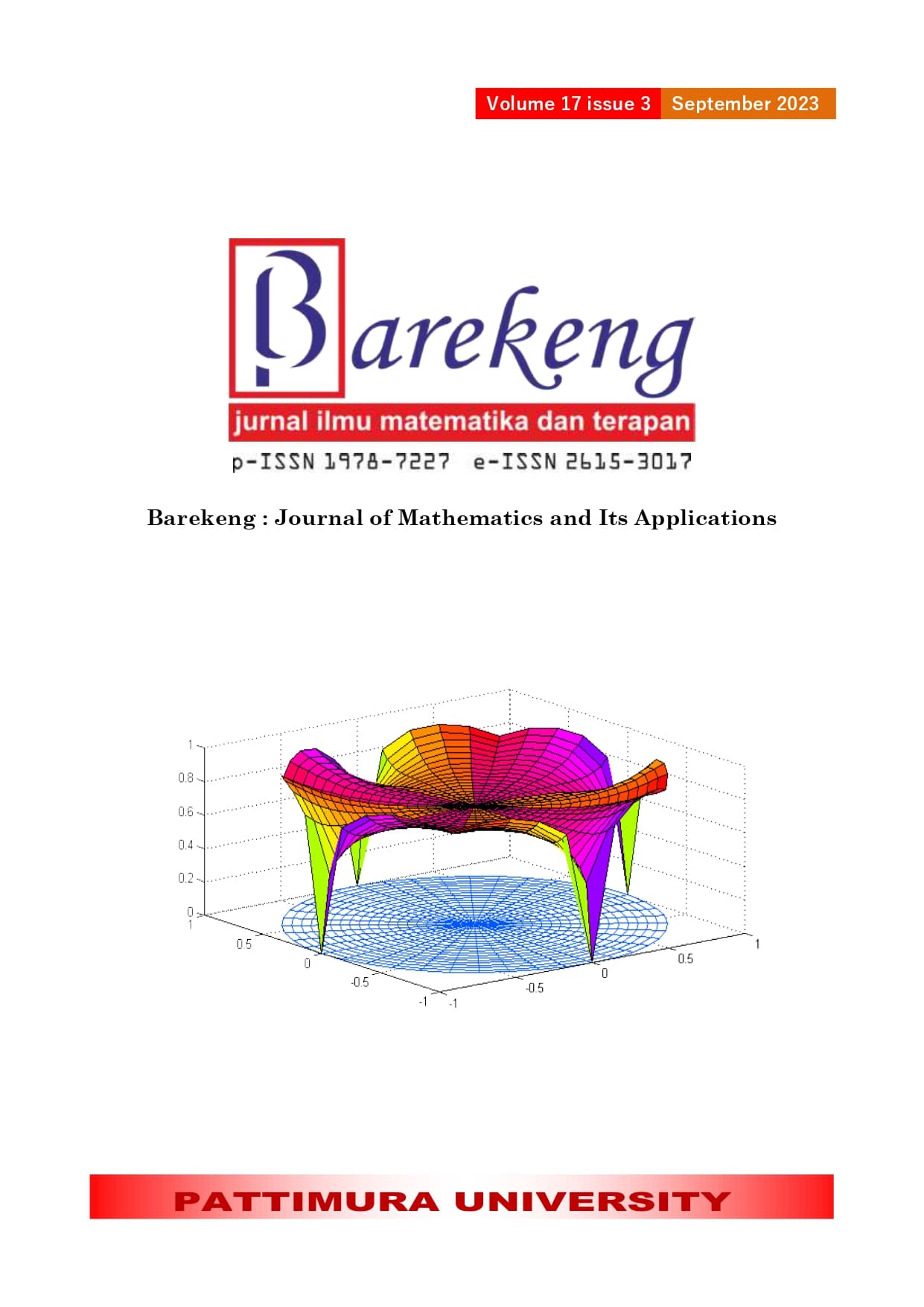INCORPORATING COMPLEX SURVEY DESIGN FOR ANALYSING THE DETERMINANT OF WOMEN IN REPRODUCTIVE AGE PARTICIPATION IN FAMILY PLANNING PROGRAM IN INDONESIA
Abstract
Data generated from complex survey are often treated as un-weighted simple random samples by analyst. This is unfortunate because everyone has different probability to be selected as sample in each stage of the complex survey design. Fail taking it into account will have serious impact in parameter and variance estimation. This paper aims to examining relationship between participation in family planning program and socio demographic status of women in reproductive age in Indonesia used data from latest Indonesian’s Demographic and Health Survey (IDHS). IDHS employs a multi stage stratified sampling design, thus there are a number of weights included in public-use IDHS datasets to account for this complex sample design. We found that the complex design features of the IHDS increased the variance estimates of the estimated parameters in the logistic regression models by about 1.325 – 1.88 times, compared to a simple random sampling. Therefore, using variance estimated from un-weighted simple random samples would lead to wrong conclusion of the significance parameter suggested by the model. The result also found that all of socio demographics variables used as predictors are significant. Thus, women with moderate education, unemployment, exposed by media, living in rural community and wealthy, have spouse that have moderate education and have a job tend to participate in family planning program.
Downloads
References
BPS, “Potret sensus penduduk 2020 menuju satu data kependudukan indonesia,” Jakarta, Indonesia, 2021.
Bappenas, BPS, and UNFPA, Proyeksi Penduduk Indonesia 2015-2045 Hasil SUPAS 2015. Jakarta: BPS-RI, 2018.
M. Gayatri, “Determinants of Contraceptive Use in Rural Poor Areas: Evidence From Indonesia,” Indones. J. Public Heal., vol. 18, no. 1, pp. 34–46, 2023, doi: 10.20473/ijph.v18i1.2023.34-46.
Q. Sserwanja, P. Turimumahoro, L. Nuwabaine, K. Kamara, and M. W. Musaba, “Association between exposure to family planning messages on different mass media channels and the utilization of modern contraceptives among young women in Sierra Leone: insights from the 2019 Sierra Leone Demographic Health Survey,” BMC Womens. Health, vol. 22, no. 1, pp. 1–10, 2022, doi: 10.1186/s12905-022-01974-w.
R. Wani, I. Rashid, S. Nabi, and H. Dar, “Knowledge, attitude, and practice of family planning services among healthcare workers in Kashmir – A cross-sectional study,” J. Fam. Med. Prim. Care, vol. 8, no. 4, p. 1319, 2019, doi: 10.4103/jfmpc.jfmpc_96_19.
National Population and Family Planning Board (BKKBN), S. I. (BPS), M. of H. (Kemenkes), and ICF, Demographic and Health Survey 2017. Jakarta: BKKBN, BPS, Kemenkes, and ICF, 2018.
R. Amelia, I. Indahwati, and E. Erfiani, “The ordinal logistic regression model wiht sampling weights on data from the national socio-economic survey,” BAREKENG J. Ilmu Mat. dan Terap., vol. 16, no. 4, pp. 1355–1364, Dec. 2022, doi: 10.30598/barekengvol16iss4pp1355-1364.
D. Yang et al., “Drinking water and sanitation conditions are associated with the risk of malaria among children under five years old in sub-Saharan Africa: A logistic regression model analysis of national survey data,” J. Adv. Res., vol. 21, pp. 1–13, Jan. 2020, doi: 10.1016/j.jare.2019.09.001.
R. Salam and A. Adji, “Application of Logistic Regression Modeling for Complex Survey Data on Education Continuity of Poor Households Children,” Proc. Int. Conf. Data Sci. Off. Stat., vol. 2021, no. 1, pp. 659–665, 2022, doi: 10.34123/icdsos.v2021i1.228.
T. N. Croft, A. M. J. Marshall, and C. K. Allen, Guide to DHS Statistics. Rockville, Maryland, USA: ICF, 2018.
M. Gayatri and B. Utomo, “Contraceptive method use in Indonesia: Trends and determinants between 2007, 2012 and 2017,” Indian J. Public Heal. Res. Dev., vol. 10, no. 12, pp. 1818–1823, 2019, doi: 10.37506/v10/i12/2019/ijphrd/192130.
S. G. Heeringa, B. T. West, and P. A. Berglund, Logistic Regression and Generalized Linear Models for Binary Survey Variables. London: CRC Press, Taylor & Francis Group, 2020. doi: 10.1201/9781420080674-9.
D. W. Hosmer and S. Lemeshow, Applied Logistic Regression, Second. New York: John Wiley & Sons, Inc., 2000.
D. N. Fajarningtiyas, D. Sulistiawan, M. M. P. Naibaho, and R. F. Arifa, “Pattern and determinant of contraceptive use among women in indonesia from 2007 to 2017: Evidence from demographic and health survey,” Open Access Maced. J. Med. Sci., vol. 9, pp. 1363–1370, 2021, doi: 10.3889/oamjms.2021.7417.
N. Indriyawati, K. A. Susiloretni, and N. Najib, “THE CURRENT USE CONTRACEPTION IN INDONESIA,” J. KEBIDANAN, vol. 9, no. 2, p. 174, Oct. 2019, doi: 10.31983/jkb.v9i2.5309.
Z. Abita and D. Girma, “Exposure to mass media family planning messages and associated factors among youth men in Ethiopia,” Heliyon, vol. 8, no. 9, p. e10544, 2022, doi: 10.1016/j.heliyon.2022.e10544.
M. F. Asif, Z. Pervaiz, J. R. Afridi, G. Abid, and Z. S. Lassi, “Role of husband’s attitude towards the usage of contraceptives for unmet need of family planning among married women of reproductive age in Pakistan,” BMC Womens. Health, vol. 21, no. 1, pp. 1–7, 2021, doi: 10.1186/s12905-021-01314-4.
Copyright (c) 2023 Erni Tri Astuti, Rini Rahani, Setia Pramana

This work is licensed under a Creative Commons Attribution-ShareAlike 4.0 International License.
Authors who publish with this Journal agree to the following terms:
- Author retain copyright and grant the journal right of first publication with the work simultaneously licensed under a creative commons attribution license that allow others to share the work within an acknowledgement of the work’s authorship and initial publication of this journal.
- Authors are able to enter into separate, additional contractual arrangement for the non-exclusive distribution of the journal’s published version of the work (e.g. acknowledgement of its initial publication in this journal).
- Authors are permitted and encouraged to post their work online (e.g. in institutional repositories or on their websites) prior to and during the submission process, as it can lead to productive exchanges, as well as earlier and greater citation of published works.






1.gif)



